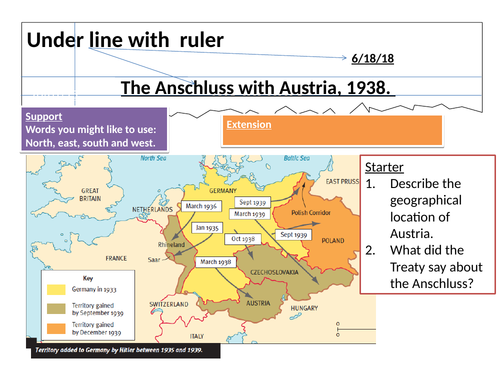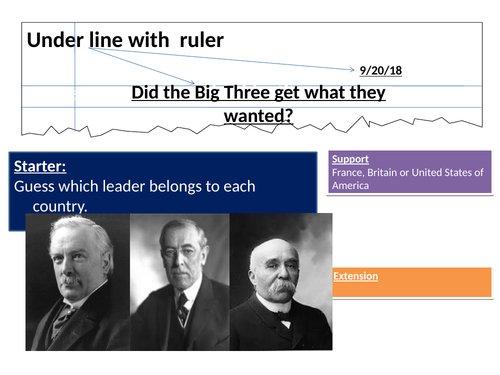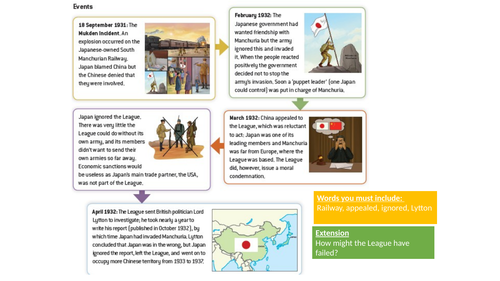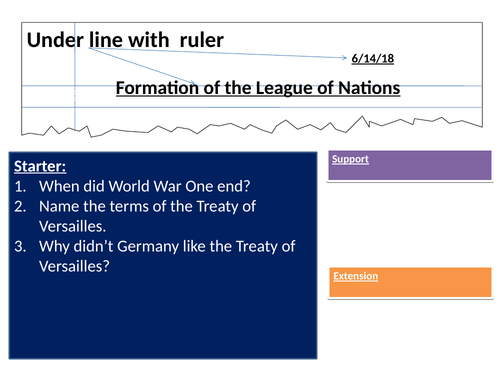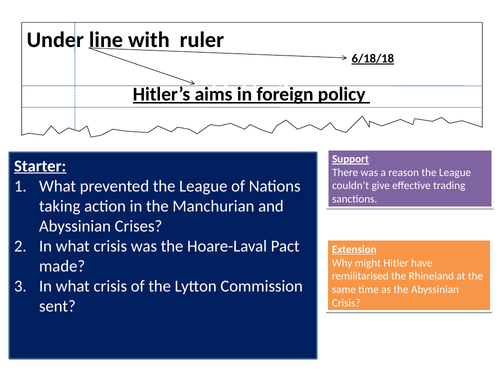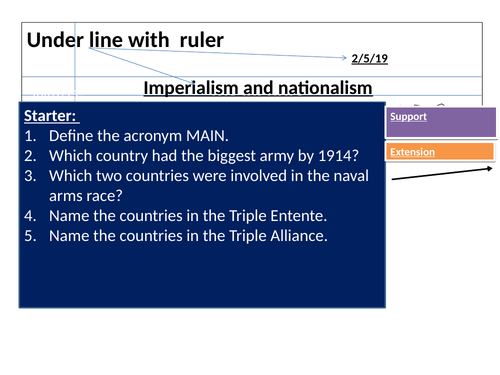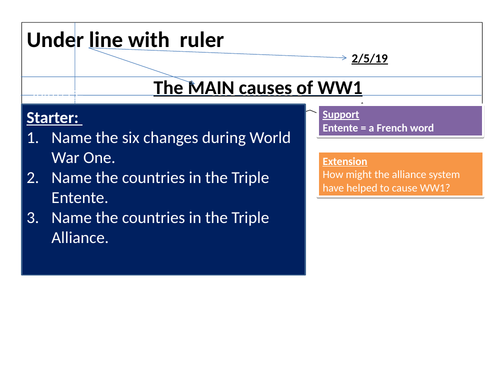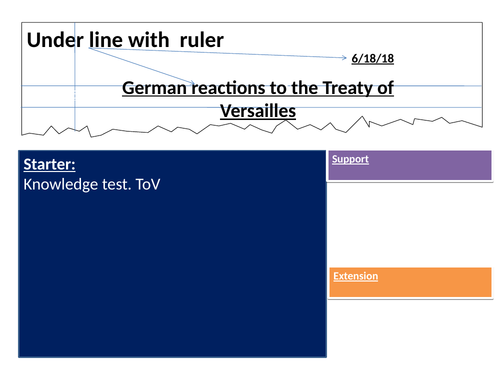60Uploads
11k+Views
16k+Downloads
Featured resources

Cause of WW1 (unit of work) KS3
This is a Key Stage 3 scheme of work that aims to develop knowledge and a casual understanding of the Frist World War. There are seven lessons included, plus an assessment:
What was WW1?
Militarism
Alliances
Imperialism
Nationalism
Assassination and July Crisis
What caused WWI?
Assessment
Also, included is a knowledge organiser. There are 30 questions designed for pupils to use to self-study at home. These are then tested in every lesson until lesson 7. Included on the knowledge organiser is also a timeline of events and a list of keywords sorted into alphabetical order.
Starter activities are knowledge recall with elf assessment.
There are clear opportunities for peer assessment with examples of WWW and EBI that pupils are able to use.
Group work, individual work, and teacher-led learning are included as a part of the scheme of work.
Reading materials are included in the lesson. Militarism and alliances include a choice of reading that is at reading age 10 or 12. Both include self assessment.

Hitler's aims in foreign policy
Hitler’s aims in foreign policy.
Use for IGCSE.
No textbook required.

iGCSE China: conflict, crisis and change, 1900–89 (Edexcel paper 2 - B4) history
igcse China (Edexcel paper 2 - B4)
This is a series of lessons that covers Edexcel’s iGCSE history B4 China: conflict, crisis and change, 1900-89.
Relevant previous exam questions are at the end of each lesson, along with the mark scheme.
Where printing is needed, this has been included as a separate document.
The lessons are squeezed into 25 lessons:
1.0 China in the 20th century
1.1 Boxer Uprising & late Qing Reforms
1.2 the causes, events, results of 1911 revolution (2.2020 Nov, a)
1.3 China under the Warlords
1.4 CCP, United Front, Soviet Union
1.5 Emergence of Chinese Communist Party
1.6 Northern Expedition, Shanghai mass (2b, June 2021, b)
2.1 The Long March (2r. June 2019 a)
2.2 War with Japan 1937-1945
2.3 Key features of the Civil War 1946-49 (2br. June 2022, b)
2.4 Cause of success (2b June 2021, Ci; 2br. June 2022, B)
3.1 Changes in agriculture (2r. June 2019; 2. 2020 Nov, b)
3.2 & 3.6 Changes in industry (2b June 2022, Cii)
3.3 Changes in the role of women (2b June 2022,a)
3.4 Political Changes
3.5 The Hundred Flowers Campaign
3.7 USSR influence (2b June 2022 Ci)
4.1 Causes of Cultural Revolution
4.2 Key features of the Cultural Revolution.
4.3 Impact of cultural revolution (2. 2020 Nov, Cii; 2br. June 2022, Cii)
4.4 Sino-Soviet split (2. 2020 Nov, Ci)
5.1 The rise and fall of ‘Gang of Four’ (2b. Nov 2021, b)
5.2 Changes under Deng (2b June 2021, Cii; 2r Nov 2020 Cii; 2br June 2022)
5.3 Deng’s opposition (2b Nov 2021; 2. Nov 2020; 2r Nov 2020)
5.4 Student opposition and Tiananmen Sq 1986-89 (2b June 2021, a; 2b June 2022, b)
• You/ your students will need Pearson Edexcel International GCSE (9-1) History: Conflict, Crisis and Change: China, 1900–1989 Student Book (ISBN 978-0435185374) as many of the lessons use this textbook.
• Each lesson begins with knowledge recall that is self-assessed.
• Relevant past exam questions are included, with mark schemes, for each lesson. So, you will teach the lesson and, at the end of the lesson are past exam questions (where applicable).
• There is also a Personalised Learning Checklist (PLC) that breaks the specification down into its constituent parts and tracks what exam questions have been asked for each topic. This reveals what topics seem to be asked multiple times and allows students to practice those questions.

CIE Cambridge IGCSE History The First World War, 1914–18
Series of lessons that covers iGCSE history, CIE Cambridge, paper 1, Depth study A, The First World War, 1914–18 (World War One, WW1)
Relevant exam questions, with mark schemes, are included at the end of lesson
Exam Map shows what is on the spec and when it was examined. This allows you to easily find exam Qs by topic.
Section 2 (To what extent was it a world war?) has never been examined, but it’s on the spec, so lessons included.
All resources are provided so no textbook is required:
1.1 Schlieffen Plan
1.2 Why did the Schlieffen Plan fail
1.3 Stalemate
1.4 Trench warfare
1.5 New weapons and methods
1.6 Verdun
1.7 Somme
2.1 British Empire on the Western Front
2.2 the war in Africa
2.3 Contribution of Japan
2.4 The Arab revolt
3.1 German threat in North Sea
3.2 Gallipoli Campaign
3.3 Eastern front and Russia leaves
3.4 The impact of war on civilian populations
4.1 Ludendorff Offensive & defeat of Germany
4.2 Hundred Days
4.3 Conditions in Germany towards the end of the war
4.4 The Armistice

AQA: First World War 1894-1918 entire unit
These lessons have been designed to be easy to follow.
Lessons follow the AQA (BA) Conflict and tension: The First World War, 1894–1918 , and include the following 26 lessons
Part one: The causes of the First World War
1.01 The alliance system (2022, Q3)
1.02 Moroccan Crises (S1, Q3)
1.03 Crisis in the Balkans (2018, Q3)
1.04 Splendid isolation
1.05 Wilhelm foriegn policy (2022, Q1)
1.06 European rearmament
1.07 Slav nationalism and Austro-Serbian rivalry
1.08 Assassination
1.09 July Crisis
1.10 cause of WW1
Part two: The First World War: stalemate
2.01 Schlieffen Plan & Belgium
2.02 Trenches and Marne (2020, Q3)
2.03 military tactics and technology
2.04 Verdun
2.5 Somme (S2, Q2)
2.06 Passchendaele
2.07 Haig
2.8 Gallipoli (2018, Q1)
2.09 War at sea
Part three: Ending the war
3.01 Russia leaves (2019, Q1)
3.02 USA enters WW1 (S2, Q1)
3.03 tactics and technology (2019, Q2)
3.04 Ludendorff Offensive (2021, Q4; S2, Q3)
3.05 Hundred Days
3.06 end of WW1 (2022, Q2)
3.07 Cause of Germany’s defeat (2018, Q2; 2020, Q4)
The lessons use the Oxford Conflict and Tension: First World War 1894-1918 book (9780198429005); HOWEVER, there is an alternative for every time the textbook has been included. You will just need to print the reading sheets.
The lesson clearly displays where an exam question has been used and includes the mark scheme.
All comprehension activities have the answers included on the next slide.
Lessons include links to YouTube for engagement.
Bundle

Edexcel Cold War Lessons and resources
Bundle covers the entire Period Study.
Includes exam questions and mark schemes
Printable resources included
AfL includes answers on the next slide.

Edexcel Cold War Key Topic 1
This is a series of 10 lessons (with a ppt with all the exam Qs for this section) that follows Edexcel History Superpower relations and the Cold War, 1941–91. Exam questions are included within the lessons and in a separate ppt for revision.
You don’t need to published textbook with this series of lessons, but it can easily be substituted in.
Lessons in total with resources to print:
introduction to Cold War
Tehran, Yalta and Potsdam
Impact of the atomic bomb, telegrams, and Soviet satellite stats
Truman Doctrine
Cominform, Comecon, and NATO
Berlin Crisis
Significance of arms race and Warsaw Pact
Hungarian uprising (causes and Khrushchev’s response)
International reaction to invasion
A ppt with all the exam Qs (up to 2022) with mark schemes for key topic one.
An overview lesson with worksheet to accompany
Every lesson starts of with 5 recall questions with the answers
Past exam questions and mark schemes are included in the lessons
Exam questions with the mark scheme are included
Each activity had an AfL activity, often with answers
Possible to use the published textbook or to use the resources provided.

English Civil War (unit of work)
This is a source-based SoW that focuses on the causes and course of the English Civil War. The SoW is broken into ten lessons:
Gunpowder Plot
Primary source 1
Charles I and Parliament
Primary source 2
Start of the English Civil War
Causes of the English Civil War
Events of the English Civil War
Execution of Charles I
Primary source 3
Assessment (source based assessment.
Where there is reading to complete (lessons 1, 3, 5, 7, 8) there is a choice of reading age of 12 or 10. The reading age has been determined using the Flesch-Kincaid readability test* and all reading comes with five comprehension questions that can be self-assessed.
There are opportunities for pupils to peer assess their own PEE paragraphs using the success criteria provided.
This unit of work includes:
• Ten lessons. Five of these lessons have a comprehension-based reading activity targeted at reading age 12 or ten, depending upon the ability of the group.
• All lessons have blooms related to learning objectives.
• A SoW that links learning activities to the learning objectives. There is also an intention statement.
• A knowledge organiser that is editable.
• While the assessment lesson is a source based it can easily be edited into causation.
The Flesch-Kincaid reading method is a readability test designed to assess the complexity of written text. It was developed by Rudolf Flesch and J. Peter Kincaid in 1975 and has since become one of the most widely used methods to determine the readability of texts in English.The Flesch-Kincaid reading method calculates the reading ease and grade level of a piece of writing based on two primary factors: average sentence length and average number of syllables per word

British Empire (unit of work)
This scheme of work focuses on how imperialism has developed over time with a focus on the development of India and scramble for Africa.
These lessons are easily adaptable and followed with clear instructions and a scheme of work
This unit of work includes:
10 lessons, plus assessment
A written SoW. Learning objectives are linked to suggested learning activities.
Where there is reading, there is a choice of reading ages to use.
There are 10 lessons int he unit of work, plus one assessment:
What was the British Empire?
Motives for imperialism
East India Company
Cause of EIC taking over India
Indian rebellion
Impact of empire on Britain
Berlin conference
Scramble for Africa
Contemporary interpretation of Empire
Preassessment lesson
Assessment
Where there is reading to complete there is a choice of reading age of 14 or 11. The reading age has been determined using the Flesch-Kincaid readability test* and all reading comes with five comprehension questions that can be self-assessed.
There are opportunities for pupils to peer assess and self assess using the success criteria provided.
Flesch-Kincaid readability test* has been used to determine the reading age of each piece of text
The Flesch-Kincaid reading method is a readability test designed to assess the complexity of written text. It was developed by Rudolf Flesch and J. Peter Kincaid in 1975 and has since become one of the most widely used methods to determine the readability of texts in English. The Flesch-Kincaid reading method calculates the reading ease and grade level of a piece of writing based on two primary factors: average sentence length and average number of syllables per word

Edexcel Cold War Key Topic 3
This series of lessons follows Edexcel’s Superpower relations and the Cold War, 1941–91. There are printable information sheets, but this can be esily substituted with the textbook.
Seven lessons in total with resources to print.
Invasion of Afghanistan and Carter
Detente (2 lessons)
Second Cold War
Gorbachev’s new thinking (2 lessons)
Fall of the Berlin Wall
Collapse of the SU and end of Warsaw
KT3 over view lessons with worksheet
KT3 exam questions with mark schemes
Every lesson starts of with 5 recall questions with the answers
Exam questions with the mark scheme are included
Self assessment is included.
Mark schemes are included on the ppts to make peer assessment easy.
Each each question relevant to KT3 is included in the exam question ppt. It is clear what part of th spec each exam question is referring to.

US involvement in the Vietnam War, 1954-75
Edexcel Key topic 3, option 33.
9 lessons, including an introduction lesson. The lessons include all the relevant past exam questions. These include 2018, Q3a; 2019, Q2; 2020, Q2&3.
I have also included an exam map.
There is printing for lesson 2. The rest of the printing is in a booklet.
To complete these lessons you will need the *Edexcel GCSE (9-1) History (The USA, 1954-1975: conflict at home and abroad) textbook. ISBN 978-1292127323

Edexcel Cold War Key topic 2
This is a series of lessons that follows the Edexcel P4 Superpower relations and the Cold War, 1941–91.
You don’t need the text book with this series of lessons but it can easily be substituted in.
7 lessons included with printable resources.
The Rufugee problem in Berlin
The Berlin Wall
Cuba (Bay of Pigs)
The Cuban Missile Crisis
Prague Spring ( 2 lessons)
Key Topic 2 overview lesson with worksheet
All exam questions and mark schemes relevant for Key topic 2 in one ppt.
All exam questions for this Key Topic are included (SAMs to 2022). Mark schemes included.
AfL activities included with answers after.
Each lessons starts off with recall activity (answers on the next slide).
Self assessment is included in the lesson.
Very Little editing required.

What was the Industrial Revolution?
This is a stand alone lesson that explores the key themes of the Industrial Revolution.
Link to FULLY RESOURCED SoW here https://www.tes.com/teaching-resource/resource-12888896
Learning objectives:
identify changes from 1750 to 1900.
describe the changes that took place from 1750 to 1900.
Explain the impact of change over 150 years.
There is printing for this lesson. AfL is included. This includes the answers to the activities.

The best IT based AfL tools
IT based Assessment for Learning tools.
These Assessment for Learning tools can greatly enhance your teaching methods by providing real-time feedback, promoting engagement, and allowing you to tailor instruction to meet your students’ needs. Remember to choose the tool that best aligns with your teaching style and objectives.
This is a table with the ten best tools with links, description and how to use.

First and second Moroccan Crisis
GCSE Modern World History (Walsh, 2001) has been used for the lesson.

Political impact of the Treaty of Versailles.
Political impact of ToV.
No textbook required.
Used for IGCSE History.

German reactions to the Treaty of Verailles
AQA textbook required. Many other textbooks will include the same content.

